MIGHTY NINETY
The mass attack against Task Group 58.3, 11-12 April 1945
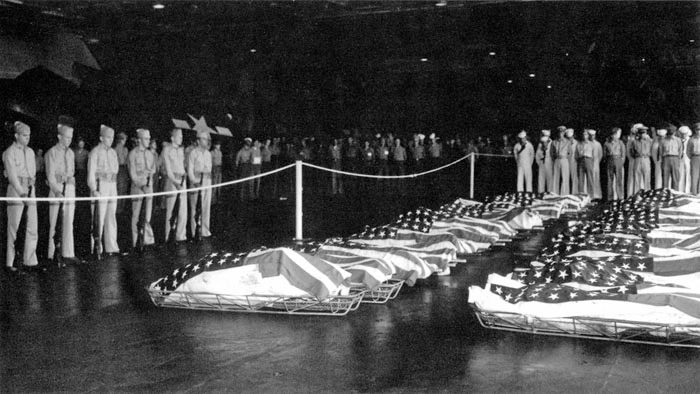
CLICK PHOTO TO ENLARGE
Funeral services on the hangar deck of USS HANCOCK, 9 April 1945. Her casualties from the 7 April attack came to 72 men killed, 82 wounded.
-U.S. Navy photo reproduced from Okinawa 1945, Huber

HANCOCK Sailors and Marines bury their dead at sea, 9 April 1945. Some men were blown overboard in the attack and were never recovered.
-U.S. Navy photo reproduced from www.navsource.org
9 April 1945
The Fast Carrier Task Force moved away from Okinawa to rearm and resupply from the Logistic Supply Group. The film shot aboard CL-90 by fleet photographer Charles McGillis was transferred to USS BUNKER HILL via the destroyer STEMBEL. The two wounded aircraft carriers--HANCOCK and CABOT--were detached with escort to return to anchorage for repairs.
The next day the task force headed back toward Okinawa Gunto. Along the way strikes were conducted against Minami Daito Jima. Carriers and battleships topped off fuel for the smaller ships. At mid-afternoon, USS ENTERPRISE and the light cruiser OAKLAND CL-95 joined up with Task Group 58.3. With the departure of HANCOCK and CABOT, Admiral Mitscher had shifted the night element of the task force into his short-handed group.

CLICK IMAGE TO ENLARGE
A track chart of USS ASTORIA from 9-10 April 1945 illustrates the Fast Carrier Task Force moving in close to Okinawa Gunto for the next round of strikes supporting the invasion. The yellow arrow indicates strikes conducted against airfields and facilities on Minami Daito Jima as the force passed.
-created from Google Earth global mapping and imagery
11 April 1945
In the early morning, strikes were launched against Okinawa, Amami, and Kikai Shoto. Based on the bragging of a bailed-out Kamikaze pilot captured on 6 April, the fast carriers were expecting the next wave of attacks to take place today. In preparation, CAP coverage had been strengthened and planes below decks were de-gassed.
Throughout the morning and early afternoon, things remained quiet--until 1330, when a large radar signal was detected. Combat Information Centers across the task force sprung to life.
ASTORIA Ship's Chaplain Alpheus M. Lusk recounted:
In the afternoon at approximately 1400 the general alarm sounded again. This time we did not receive the usual greeting upon arrival at our battle stations. Instead of one to three planes escaping the CAP, we heard the Gunnery Officer's calm words:
"Some 40 enemy planes have just succeeded in getting through the Combat Air Patrol and are coming in on the fleet. Settle down, this looks as if it might be it."
The incoming wave of planes divided its attention between task groups, but ASTORIA's group caught the brunt of the attacks. Given that multiple planes descended upon the group within seconds of each other, Herman Schnipper and his fellow Navy combat photographers did a remarkable job capturing the fast moving events. Many of the images below were taken in rapid succession from multiple vantage points.
At 1405, ASTORIA was steaming near the head of the formation, off the port beam of ENTERPRISE when the first Kamikaze planes appeared. Two bomb-laden Zekes dove on ENTERPRISE from astern. They were taken under heavy fire by other ships, but due to her relative position ASTORIA did not have a clear firing arc. The first plane was hit repeatedly. It fell short of its objective and crashed close astern of the carrier. A second plane followed closely on its heels.

CLICK PHOTO TO ENLARGE
Herman Schnipper took this photograph at 1405 as the first two planes dove on ENTERPRISE. The first plane has just crashed and its bomb detonated astern. The smoke trail from its dive is clearly visible. The second plane (circled) has just been struck by antiaircraft fire and is less than a second from impact. ENTERPRISE is steaming at 25 knots and turning sharply in order to make a more difficult target.
-photo taken by and courtesy of USS ASTORIA ship's photographer Herman Schnipper

A photo taken aboard ENTERPRISE a second later. The Zeke crashed against the ship's port quarter 40mm mounts, damaging the splinter shields and raining debris into the gun tubs. One man was thrown overboard and two were injured. In this image the plane's bomb has just detonated beneath the ship.
-U.S. Navy photo reproduced from www.cv6.org
The second plane's bomb detonation caused ENTERPRISE to lift slightly out of the water. The ship's foremast whipped and her SK air search radar ground to a halt, out of commission. Her main generators and turbines suffered structural damage, causing intense vibration at the 25 knots she was running. Aft bulkheads separated and water seeped into the ship, causing a slight list to develop. An oil slick soon began to trail in ENTERPRISE's wake.
Within a couple of minutes two more planes came in. USS WILKES-BARRE was in position to fire, and she let loose with 5-inch and 40mm guns. The third attacking plane was struck early in its approach and it crashed well clear of the task group. The fourth was also hit by heavy antiaircraft fire during its dive, burst into flames, and crashed astern of BUNKER HILL.

CLICK PHOTO TO ENLARGE
At 1408 the fourth attacking plane crashes astern of USS BUNKER HILL. The height of the water plume indicates that a bomb detonated on impact. ASTORIA is ahead of BUNKER HILL in the formation. This photo was likely taken from her sister cruiser SPRINGFIELD.
-U.S. Navy photo from Brent Jones collection
At 1411, six minutes into the intense attack, a fifth plane approached on a heading toward ESSEX, the carrier in line behind ENTERPRISE. USS ASTORIA finally had a clear firing arc and good range. She opened up with her 5-inch battery and WILKES-BARRE joined in from across the task group. The Zeke lost its tail in the heavy fire and plunged into the water, narrowly missing ASTORIA's sister cruiser PASADENA to starboard.
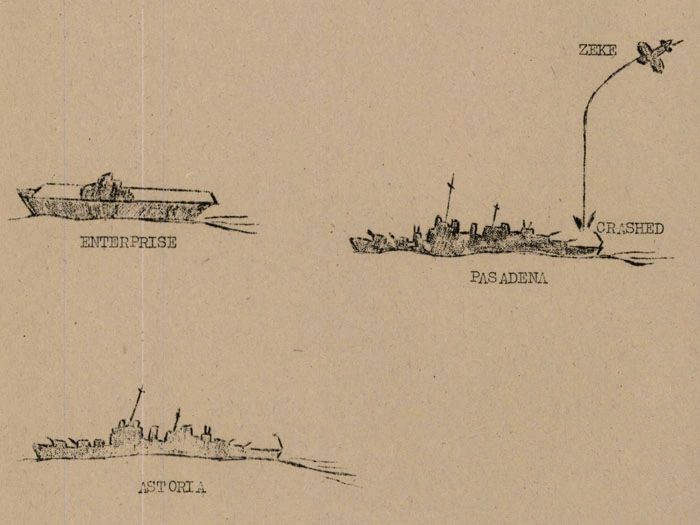
This drawing accompanied the ASTORIA CL-90 Action Report for 11 April 1945, depicting the approach and crash of the fifth attacker close aboard USS PASADENA.
-Brent Jones collection reproduced from NARA records

CLICK PHOTO TO ENLARGE
Intense 5-inch and 40mm antiaircraft fire over USS PASADENA at 1412 as the plane crashes close off her starboard quarter--the fifth attack in six minutes. This photo was taken from the Kamikaze's intended target USS ESSEX, steaming near ENTERPRISE. ASTORIA is abeam of PASADENA, out of view to port (right).
-photo taken by CPhoM Paul Madden courtesy of Herman Schnipper
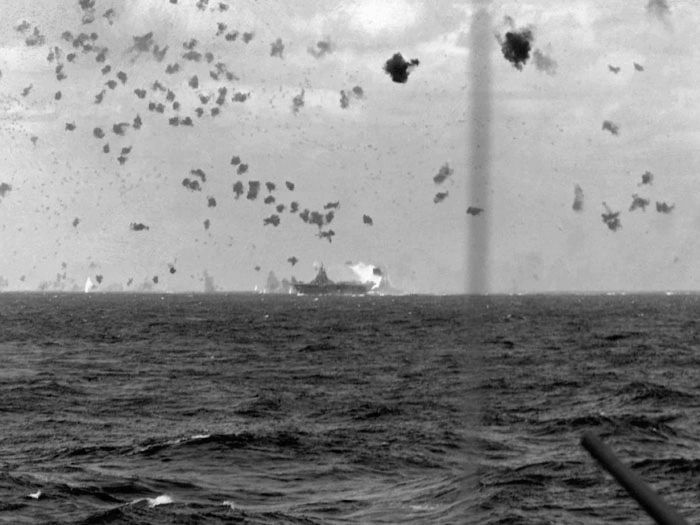
CLICK PHOTO TO ENLARGE
Remarkably, this photo was taken at almost the exact same moment and angle, but from further across the task group aboard battleship SOUTH DAKOTA. ESSEX is at center with PASADENA visible just to her right. The water plume and flak bursts are all virtually identical to the previous photo. ASTORIA and ENTERPRISE are again out of view to the right.
-photo reproduced from http://www.navsource.org/ courtesy of Pieter Bakels

CLICK PHOTO TO ENLARGE
Herman Schnipper also photographed the incident. This image was taken a few second later as PASADENA cleared the shell bursts. In this oblique angle, the settling water plume from the crashed plane is still visible in PASADENA's wake. ASTORIA's firing solution on the approaching plane fell between PASADENA and the destroyer which has entered the frame at right. CL-90 was credited with an assist for the downed plane.
-photo taken by and courtesy of USS ASTORIA ship's photographer Herman Schnipper
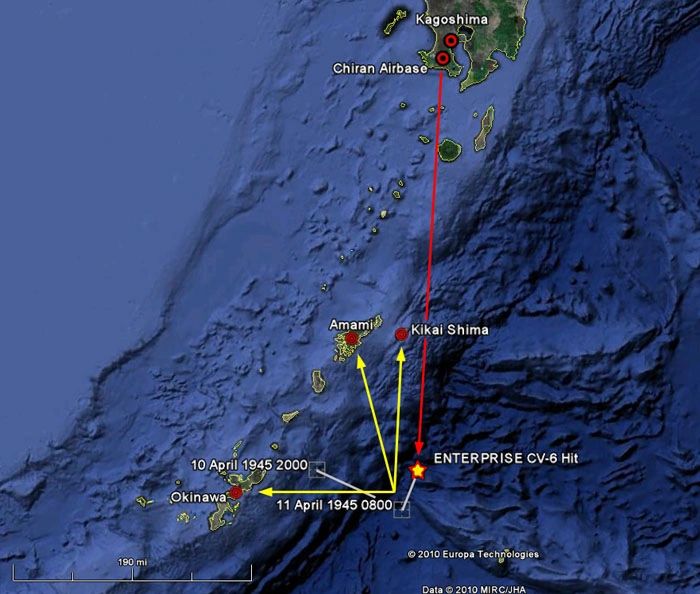
CLICK IMAGE TO ENLARGE
Track chart of USS ASTORIA on 11 April to the point that attacks began and ENTERPRISE was damaged. The yellow arrows indicate the carrier attacks conducted against Okinawa, Amami, and Kikai Shima. The Japanese Special Attack Corps Kikusui No. 2 planes originated from Chiran Airbase located in Kagoshima prefecture on the southernmost tip of the Japanese home islands.
-created from Google Earth global mapping and imagery
After the fifth plane was shot down near USS PASADENA, the action over Task Group 58.3 briefly subsided. Task Group 58.4, however, remained in the thick of the fight. At 1443, a Kamikaze plane piloted by 19-year old IJN Petty Officer 2nd Class Setsuo Ishino flew in low and struck the battleship MISSOURI BB-63 on her starboard quarter.

CLICK PHOTO TO ENLARGE
At 1443 on 11 April 1945, one of the most famous photos of the Pacific War was taken. This image shot aboard USS MISSOURI freezes the moment in time that Setsuo Ishino struck USS MISSOURI; it came to symbolize the desperate nature of the fighting against Kamikaze attacks. The plane broke apart in a glancing impact and threw debris onto the deck, igniting a fire forward.
-U.S. Navy photo reproduced from Wikimedia Commons

CLICK PHOTO TO ENLARGE
The glancing blow from Setsuo's attack caused only superficial damage as fires were quickly brought under control. This image shows one of the suicide plane's machine guns ripped from its mount and lodged into a quad 40mm barrel aboard USS MISSOURI.
-U.S. Navy photo reproduced from Okinawa 1945, Huber
Back in ASTORIA's task group, a bright spot for the day occurred; a destroyer reported that it had picked up the ENTERPRISE gunner who was blown overboard. He had amazingly survived the bomb explosion beneath the ship. On a more ominous note, air search radar indicated more planes en route.
During the brief lull in the action, Chaplain Lusk had climbed the searchlight platform where ship's photographer Schnipper had positioned himself to photograph the action. Lusk later wrote that he had standing permission to mingle among the men when his duties did not require him elsewhere, but it was no secret to the ship's Captain or crew that the chaplain wanted to see topside action firsthand.
45 minutes after the first round of attacks, the chaplain's curiosity brought him to stand alongside the ship's photographer and two electrician's mates high up in the superstructure as the next round of attacks began. Once again several planes came at the group together.
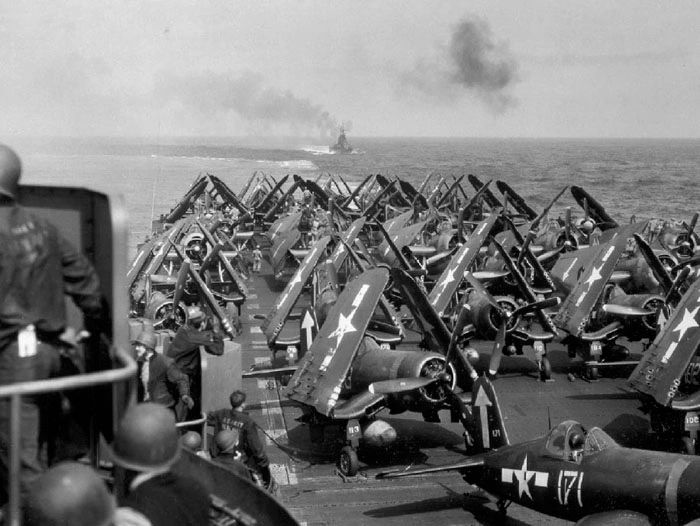
CLICK PHOTO TO ENLARGE
The view astern of USS BUNKER HILL on 11 April 1945. The light cruiser firing in the background is very likely PASADENA. Both ships are making a turn to starboard.
-U.S. Navy photo in Brent Jones collection
The sixth plane of the day made an approach on ENTERPRISE from the starboard quarter and was taken under fire by ASTORIA and other ships. The plane was hit while well astern and leveled out as it approached the carrier. Just as it crossed over ENTERPRISE, the attacker rolled over into a vertical dive and crashed very close aboard the ship's starboard bow. Its bomb exploded; plane parts erupted from the water and rained down onto ENTERPRISE's flight deck.

This drawing from the ASTORIA CL-90 Action Report for 11 April 1945 depicts the approach of the sixth plane at USS ENTERPRISE. Fire from ASTORIA struck the plane multiple times as it approached the ship. Whether the plane was brought down by gunfire or misjudgment by the pilot was never determined.
-Brent Jones collection reproduced from NARA records

The F6F Hellcat on the ENTERPRISE starboard catapult bursts into flames from the bomb explosion close aboard. Flaming aviation gasoline leaks from the plane's belly and runs along the flight deck. Fire parties bring hoses forward, but get no water pressure due to ruptured lines.
-U.S. Navy photo reproduced from www.cv6.org

Captain Dyer presents awards to individual sailors on the ship's fantail before addressing the crew about their upcoming operations, 3 February 1945.
-photo taken by and courtesy of USS ASTORIA ship's photographer Herman Schnipper
Jim Thomson wrote in his diary:
The Old Man gives us the once-over. Feels good to get into whites again. We are given the word that we are going right into Tojo's backyard next trip. Draws a cheer from the mob.

CLICK PHOTO TO ENLARGE
Impromptu photo of N Division sailors taken following inspection, 3 February 1945. Note that ship's photographer Schnipper defaced the negative so the ships at anchorage could not be made out in detail when the photo was sent stateside.
-photo taken by and courtesy of USS ASTORIA ship's photographer Herman Schnipper
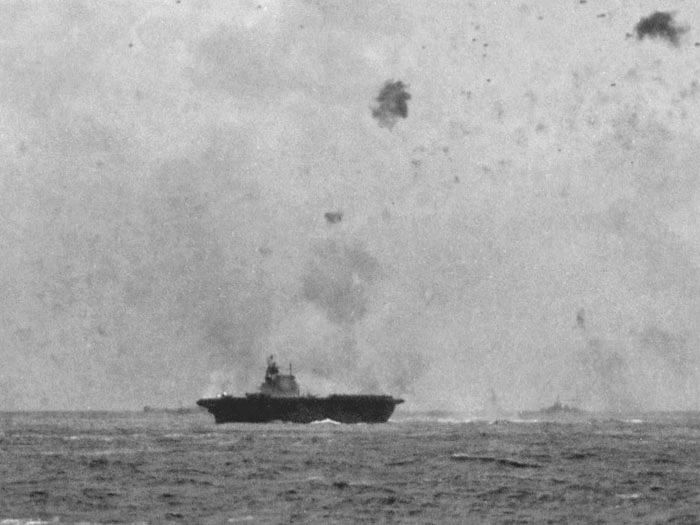
CLICK PHOTO TO ENLARGE
A close-up of Schnipper's photo clearly shows fires from the burning Hellcat on the starboard catapult of ENTERPRISE.
-photo taken by and courtesy of USS ASTORIA ship's photographer Herman Schnipper
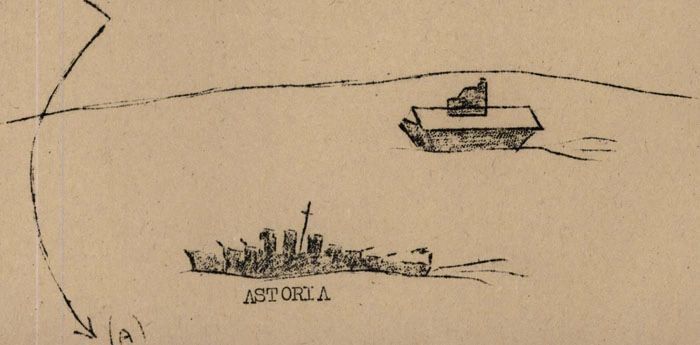
ASTORIA sailors put fenders over the side of the ship in preparation for refueling operations off Saipan, 13 February 1945.
-photo taken by USS ASTORIA ship's photographer Herman Schnipper (reproduced from Mighty Ninety Cruise Book)

CLICK PHOTO TO ENLARGE
Lookouts from L Division in decidedly more relaxed dress following inspection, 3 February 1945.
-photo taken by and courtesy of USS ASTORIA ship's photographer Herman Schnipper
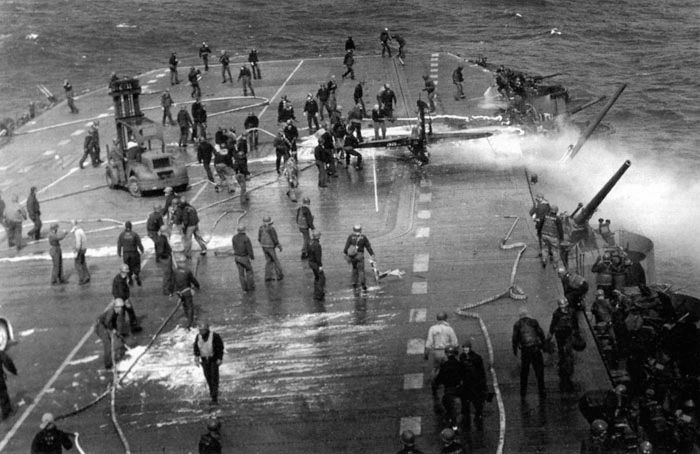
Note list
CLICK PHOTO TO ENLARGE
Impromptu photo of N Division sailors taken following inspection, 3 February 1945. Note that ship's photographer Schnipper defaced the negative so the ships at anchorage could not be made out in detail when the photo was sent stateside.
-photo taken by and courtesy of USS ASTORIA ship's photographer Herman Schnipper
4 February 1945
Jim Thomson wrote in his diary:
We [F Division] have the best inspection mark on the ship. Working parties and more working parties. Discover the sights on the 40mm are not according to Hoyle. Spend three rugged days getting them in shape.
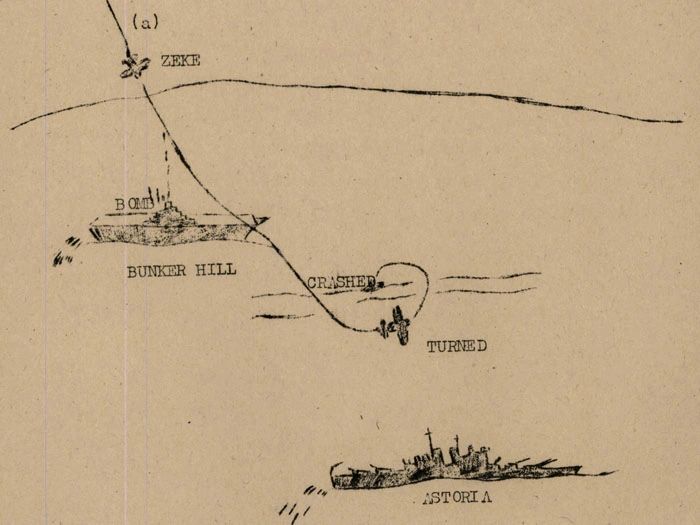
CLICK PHOTO TO ENLARGE
Task Group 58.3 gets underway from Ulithi, 10 February 1945. Taken from USS BUNKER HILL CV-17, this photo shows her Marine Corsairs spotted forward. BUNKER HILL follows COWPENS CVL-25 (left), ESSEX CV-9, and cruisers of CruDiv 17.
-U.S. Navy photo reproduced from Wikimedia Commons
Lind, J. Fred. Sea Attitudes: A Collection of WWII Memories. Privately published.

CLICK PHOTO TO ENLARGE
Task Group 58.3 gets underway from Ulithi, 10 February 1945. Taken from USS BUNKER HILL CV-17, this photo shows her Marine Corsairs spotted forward. BUNKER HILL follows COWPENS CVL-25 (left), ESSEX CV-9, and cruisers of CruDiv 17.
-U.S. Navy photo reproduced from Wikimedia Commons
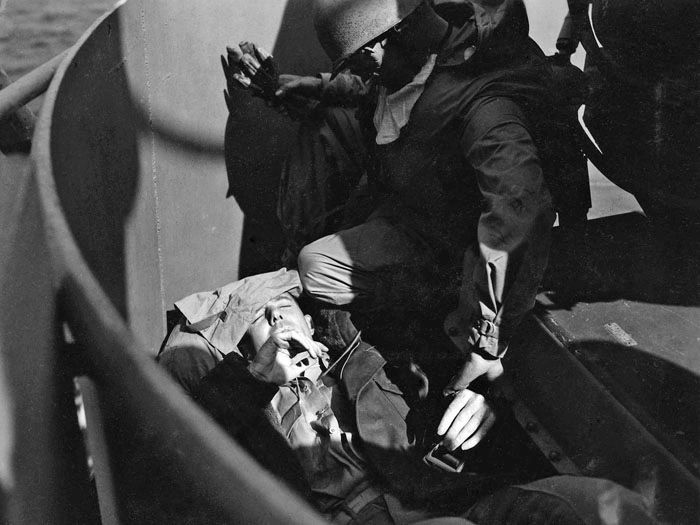
Note dress of other sailor, taking pulse. Electricians in suits not injured, crease in helmet.
As ASTORIA steamed from Ulithi, her crew knew that big operations were coming but did know specifics. Fred Lind wrote:
On the 10th we left port with the whole fleet. We are really going to make history this time. There is a new invasion coming off and we are going to herd them in. It will be the closest thing to

The bomb reported by some ASTORIA observers was actually the burning F6F launched from the starboard catapult off ENTERPRISE.
Cold weather clothing was issued. We expect to get into a climate similar to that of

As gunnery drills continued, ASTORIA maintained her fine reputation. Jim Thomson wrote:
We are headed for a cold climate--heavy clothing being issued. Spent the day firing. Some beautiful shooting. Five-inch lay out 125 rounds to get drone. Forties look better than ever. Good line-up job.
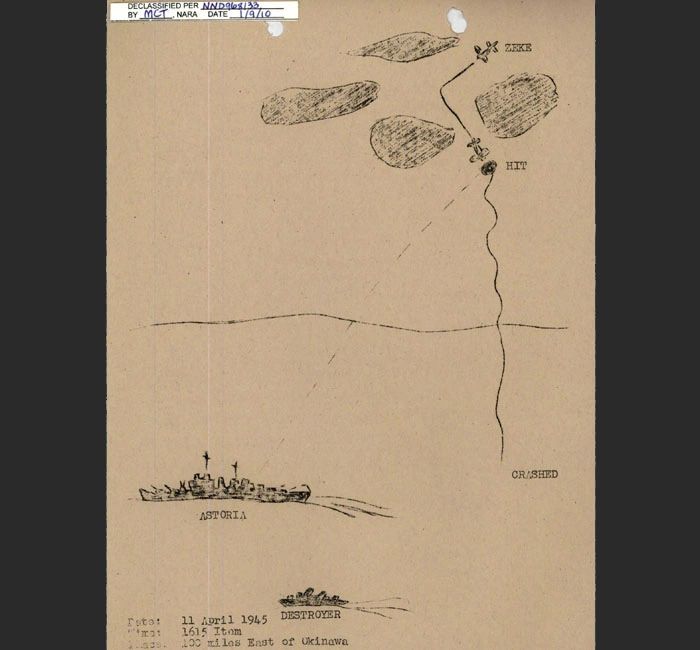
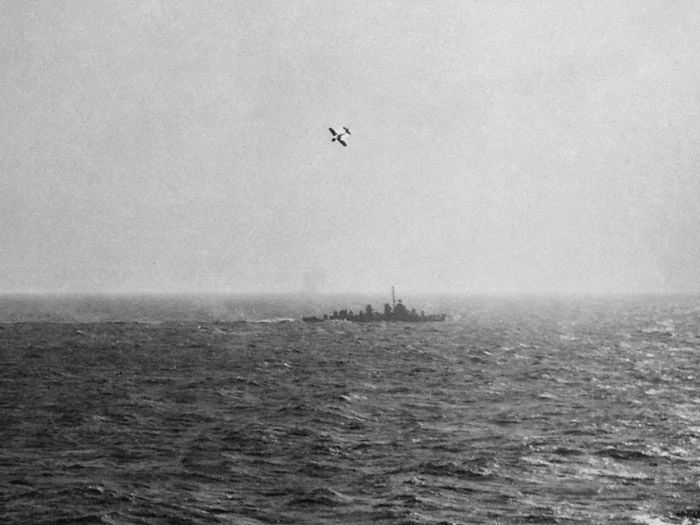
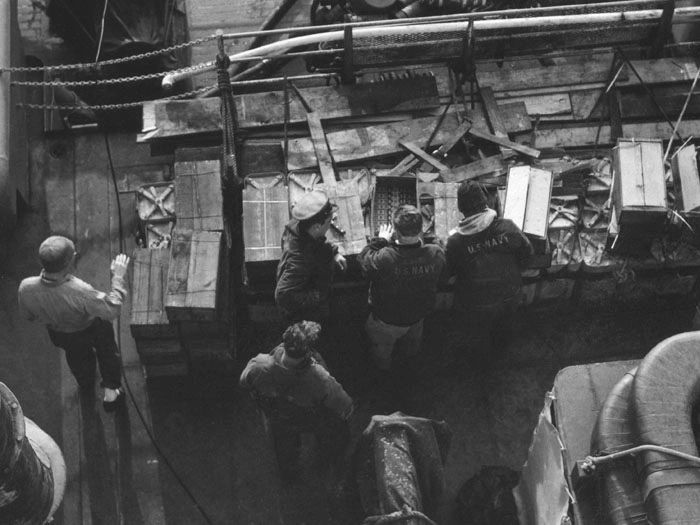


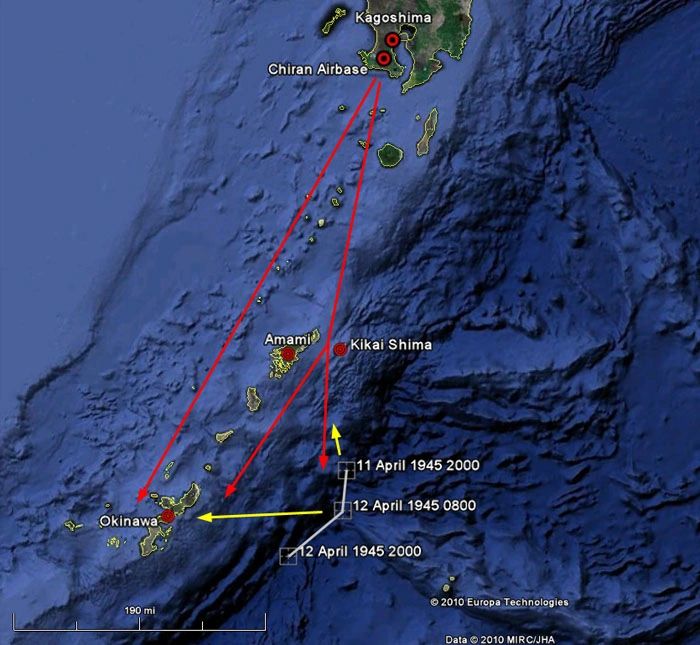
ASTORIA sailors put fenders over the side of the ship in preparation for refueling operations off Saipan, 13 February 1945.
-photo taken by USS ASTORIA ship's photographer Herman Schnipper (reproduced from Mighty Ninety Cruise Book)
14 February 1945
Jim Thomson wrote in his diary:
Fleet still fueling. Largest group ever assembled--five units. Probably 15 carriers, 15 battleships, 15 cruisers, and a hundred or so destroyers. Lookout Tojo. We are on the way north that night.
Thomson was not too far off the mark. With the addition of three fleet carriers (RANDOLPH CV-15, BUNKER HILL CV-17, and BENNINGTON CV-20), Task Force 58 had sixteen total carriers spread across five task groups--four for daytime and one for night operations. There was, however, an underlying cause for apprehension; almost half the air groups involved would be conducting their very first combat mission.
15 February 1945
From the Mighty Ninety Cruise Book:
After we had been to sea several days we found we were going to raid
Jim Thomson wrote:
News is out that it is Tokyo. All equipment gets a last-minute check. Cold weather clothing is issued--I wear two heavy underwear tops.
From Morison's Victory in the Pacific:
Everything possible was done to guard against detection. Measures included radio deception, scouting by Pacific Fleet submarines to dispose of any picket vessels there might be en route, scouting by B-29s and Navy Liberators from the Marianas to clear the air. On the 15th a scouting line of five destroyers ranged ahead of the carriers, and antisubmarine air patrol was set up. At 1900 a high-speed run-in began toward launching positions, where the carriers arrived at dawn 16 February. Thanks to these precautions, and to thick weather most of the way, they arrived undetected.

Navy pilots aboard USS ESSEX CV-9 receive final briefing prior to strikes against Tokyo,17 February 1945.
-U.S. Navy Photo reproduced from NARA collection

CLICK PHOTO TO ENLARGE
A BUNKER HILL F4U Corsair is readied for strikes on 16 February 1945. 5-inch HVAR "Holy Moses" rockets are loaded and armed under the wings.
-U.S. Navy Photo reproduced from NARA collection.
CHAPTER 1x: OPERATION DETACHMENT part 1--COMING SOON
CLICK ON PHOTOS TO ADVANCE TO NEXT CHAPTER
BACK TO SHIP HISTORY
Sources:
Aman, Joseph. Joey Fubar's Cavalcade of Humor. Printed aboard USS ASTORIA CL-90, 1945.
Bruce, Roy W. and Leonard, Charles R. Crommelin's Thunderbirds: Air Group 12 Strikes the Heart of Japan. Annapolis, MD: United States Naval Institute, 1994.
Drury, Clifford M. The History of the Chaplain Corps, United States Navy Vol. 2: 1939-1949. Washington, DC: Bureau of Navy Personnel, 1964.
http://commons.Wikimedia.org/wiki/Main_Page Wikimedia Commons image database.
http://earth.Google.com/ Google Earth.
Huber, Dr. T.M. Okinawa 1945. Havertown, PA: Casemate, 2001.
Jones, Brent. Private photo and document collection.
Morison, Samuel Eliot. History of
Peddie, Jim. Private document collection.
Reynolds, Clark G. The Fast Carriers: the Forging of an Air Navy. New York: McGraw-Hill, 1968.
Schnipper, Herman. Private photo and document collection.
Stafford, Edward P. The Big E. New York, NY: Random House, Inc., 1962.
USS ASTORIA CL-90 Action Report for Period 14 March to 27 May 1945.
USS ASTORIA CL-90 War Diary for Period 1 April to 30 April 1945.
www.archives.gov National Archives and Records Administration WWII photo archive.
http://www.cv6.org/ USS ENTERPRISE CV-6 website.
www.navsource.org U.S. Navy photo archive.
